Ghana | First Impressions of Ghana
By Ashley Young
By Ashley Young
BY CELIA CODY-CARRESE
One of my favorite works of art is The Garden of Earthy Delights by Hieronymus Bosch. A triptych painted around 1500, its three scenes depict the Garden of Eden, an excess of human pleasure on Earth, and a bizarre underworld. It’s fantastical and surreal and thus very ahead of its time, as the surrealism movement in the art world didn’t occur for centuries later. Every time I look at this painting I see something new, some detail I didn’t catch before – since there is just so much going on. Lucky for me, The Garden is housed at the Prado museum in Madrid, and I got to see it in person this past weekend. It’s displayed on a table in the middle of a gallery room, demanding attention. If you’ve ever had a favorite piece of art or even a favorite song, you know that seeing it up close, or hearing it live, is a special experience.
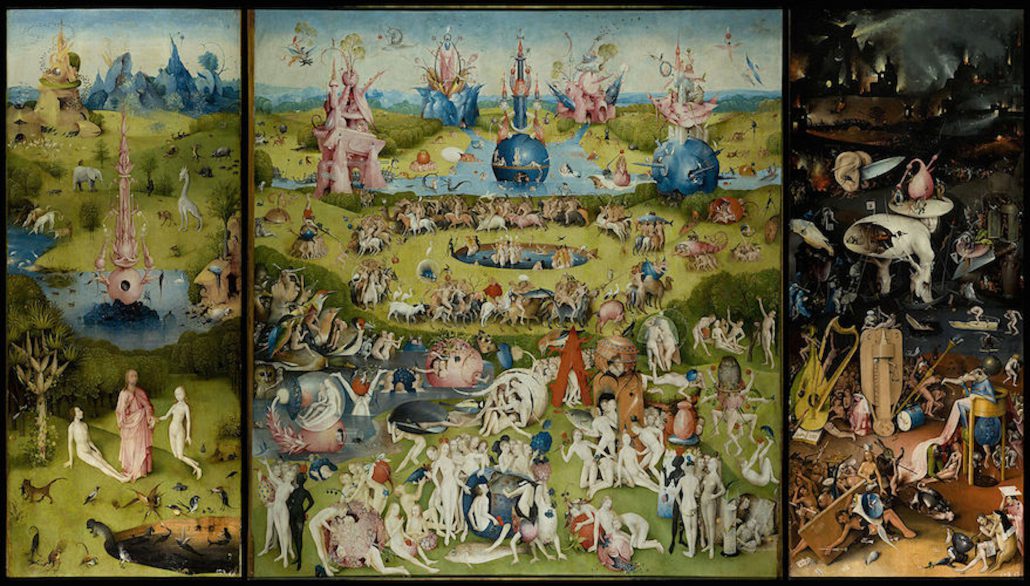
Little did I know that Hieronymus Bosch has an interesting connection to Spanish History, and that I would learn about him in my class at UCO Córdoba! Last week, my History professor pulled up the painting on Google Images and explained that the painting once belonged to Felipe II, considered one of the most important kings in Spain’s history. Felipe was extremely powerful and controlled vast territories, but at the end of his life he became a recluse, never leaving El Escorial, a grand palace he built for himself. As my professor explained, Felipe was extremely paranoid and convinced that the souls of his enemies were inside the people depicted in The Garden of Earthly Delights. Furthermore, within El Escorial Felipe had many Bosch paintings, which he arranged around his bedroom and stared at all night, instead of sleeping. He also unfortunately burned many of these paintings – but thankfully not The Garden.
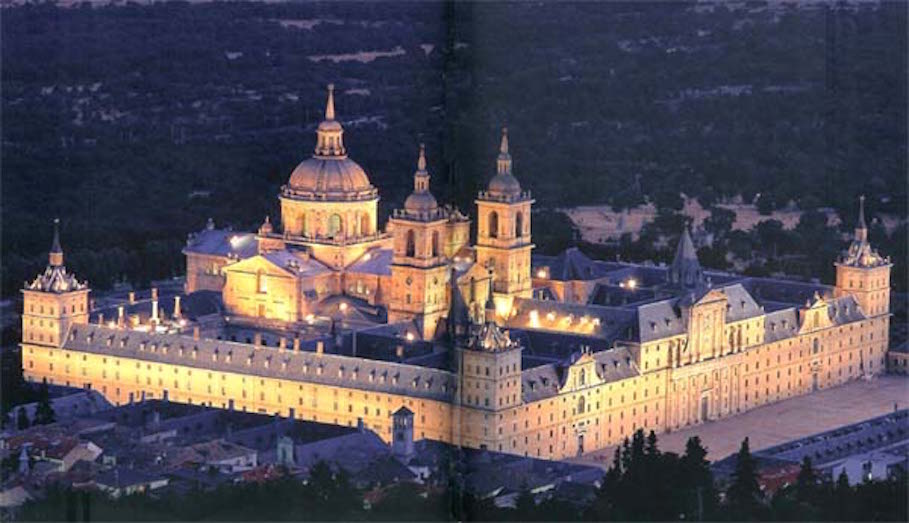
This story is really interesting to me because I already loved this painting, but also because it illustrates to me the core of what study abroad is about. I didn’t even know Bosch’s masterpiece was in Spain until I was looking up information about the Prado before I went. And I also wasn’t aware of the connection it had to Spain’s extremely powerful and influential king. To learn about it all here, and have the opportunity to see it in person, is probably the best example of “hands on learning” I’ve ever experienced.
And this isn’t the only such example of history, art, and my environment interacting in this way. Andalucía, and specifically Córdoba, were under Muslim rule for many years before the Christians came into power. During the 10th and 11th centuries, Córdoba was the capital of the Califate in Europe, Al-Andalus, and a place where Christians, Muslims, and Jews lived in relative harmony. Muslims had higher social standing and didn’t have to pay taxes, but there was not regular discrimination or violence based on religion. One of my favorite things about Andalucía and Córdoba in particular is this example of religious tolerance and coexistence. The city’s history is preserved in the architecture, such as the Mosque-Cathedral and the city’s synagogue. But it also shows up in smaller, less obvious ways, scattered throughout the city. For example, there is a small symbol you can find in various historical sites in Andalucia – my professor told me so far he has found 23 in Córdoba. It is a brass plaque on the ground, an image of Spain and Portugal which is made up of Hebrew letters. The symbol serves as a reminder of the Jewish community in Al-Andalus. I have seen one of these in Toledo as well, and they can be found in many cities that were once part of Al-Andalus. In both Córdoba and Toledo you can find synagogues, still preserved from the time when Jewish communities lived in Spain. We visited the synagogue in Córdoba on a class trip, and the interior decorations were strikingly similar to the Alhambra in Granada. The exchange of design techniques and aesthetics is clearly on display among these very distinct buildings.
Plaque of Iberian Peninsula with Hebrew letters

Synagogue in Córdoba, with Hebrew inscriptions, Arabic designs, and a painted cross
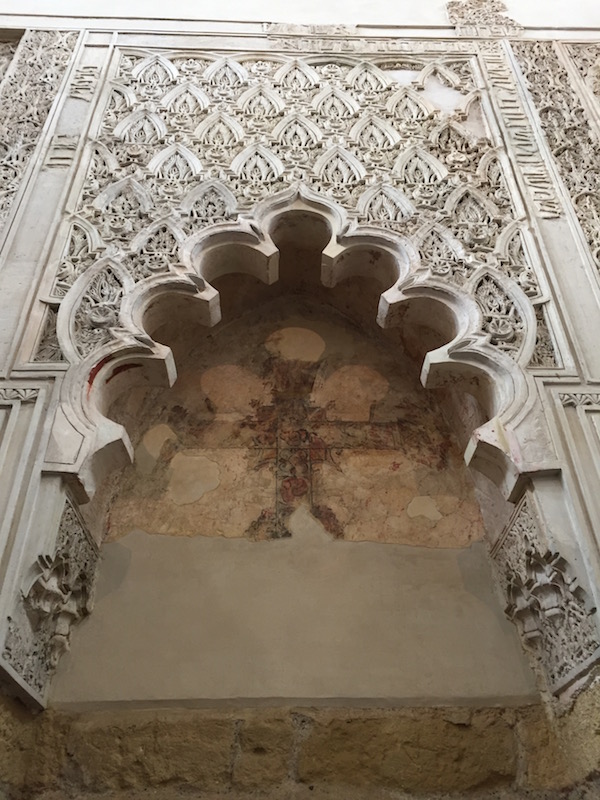
In addition to being a city of religious and cultural exchange, Córdoba was also an important political city. For the Romans, Muslims, and eventually Christians, Córdoba was a place of administrative and strategical importance. During Fernando and Isabel’s rule they lived in Córdoba, and from there directed the military campaign to expel the Muslim’s from Granada. It was at the Alcazar palace in Córdoba that Christopher Columbus came to make his case for exploration to Fernando and Isabel, and they agreed to fund his journey. We went to the Alcazar on a field trip, and in the gardens there is a statue to mark the event.
Fernando and Isabel receiving Columbus
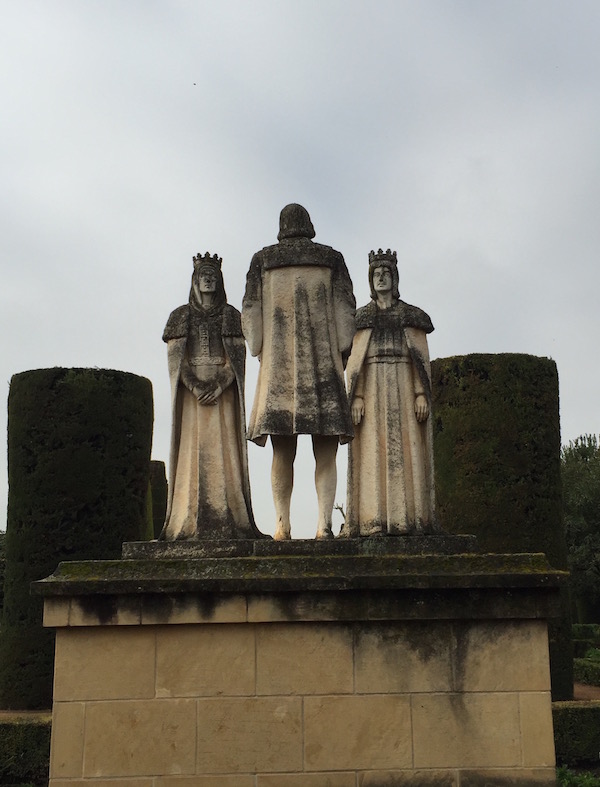
At the Alcazar there is also a room where many Roman mosaics are on display. These mosaics were created in the 2nd and 3rd centuries when the Roman Empire extended to Spain, and were discovered under a large plaza in Córdoba. The mosaics were originally the floors of homes belonging to wealthy families, and were reconstructed piece by piece for the current display. Because Córdoba was the capital city for different societies throughout history, each of them essentially just built on top of the previous civilization. Archeologists can’t uncover all of the ruins because they would literally have to tear down the current city to do so!
One of the Roman mosaics at the Alcazar in Córdoba

My history professors have both talked about what they see as a lack of historical memory in Spain. In their view, many Spanish people think of Spanish as being Catholic and European, while not understanding the historical significance of Al- Andalus and the Muslim and Jewish populations here. Similarly, in school children learn about Columbus “discovering” the new world and what a success it was for Spain, without discussing the disastrous effects his voyage had on Native Americans. Evidently, we have the same problem in the United States – I didn’t learn the other side of the story of Columbus until I was in high school. Many Americans also lack an understanding of the racial dynamics and systems of oppression throughout America’s history, which still continue today.
We travel to other countries to learn about another culture, another history, different people. This culture and history is enshrined in the streets and buildings we find ourselves amongst, in art and in stories. But the truth is there are different stories and cultures wherever we are, whether we are in our hometown or in an entirely new place. We just have to be willing to ask questions and to notice what’s around us – no matter where we are.
Celia Cody-Carrese studied abroad in Cordoba, Spain, in Winter 2017: http://eap.ucop.edu/OurPrograms/spain/Pages/exploring_andalucia.aspx
BY GRACE HEART
So by now I think I’ve pretty much nailed down my study techniques for this physics program. I do realize that everyone learns differently so some of these techniques might not work for everyone, but I will try to keep it general enough to apply to a wide variety of learners, yet specific enough to give you ideas of how I learned a year of physics in eight weeks.
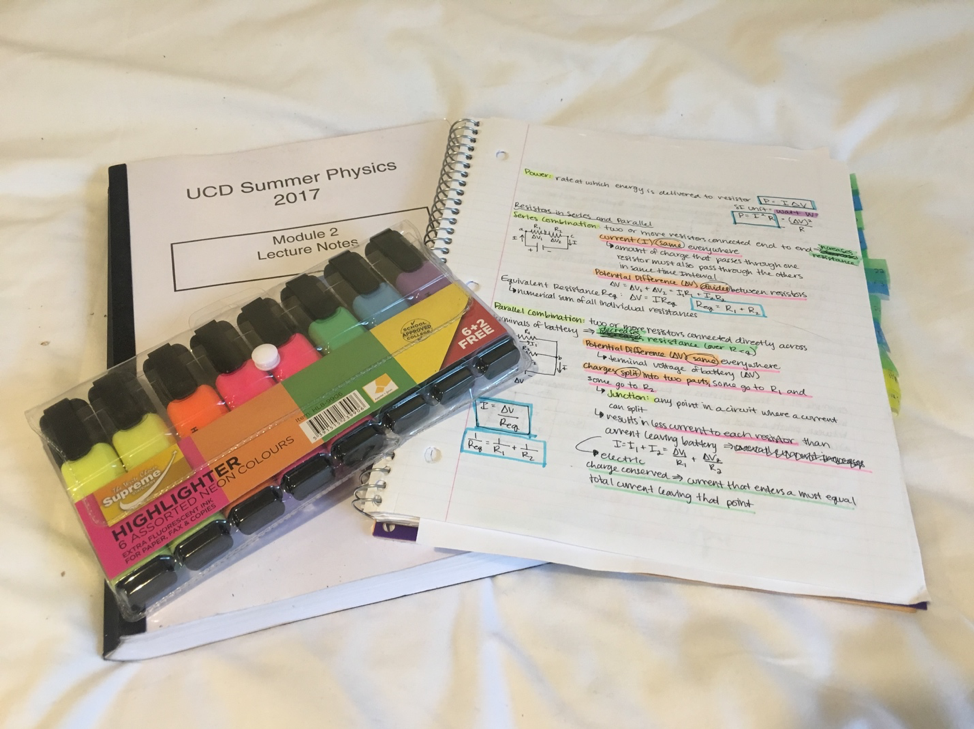
BE AN ACTIVE NOTETAKER IN LECTURE
I know it’s easy to go to 9am lecture and sit on your phone or let the material go right over your head, but paying attention will make learning the material and studying later a million times easier. Do what you need to keep yourself awake and attentive during lecture. Bring snacks, drink some coffee, etc. You will sit through two hours of lecture every day, so be sure to pay attention. I use highlighters and pens to take notes and keep track of important information.
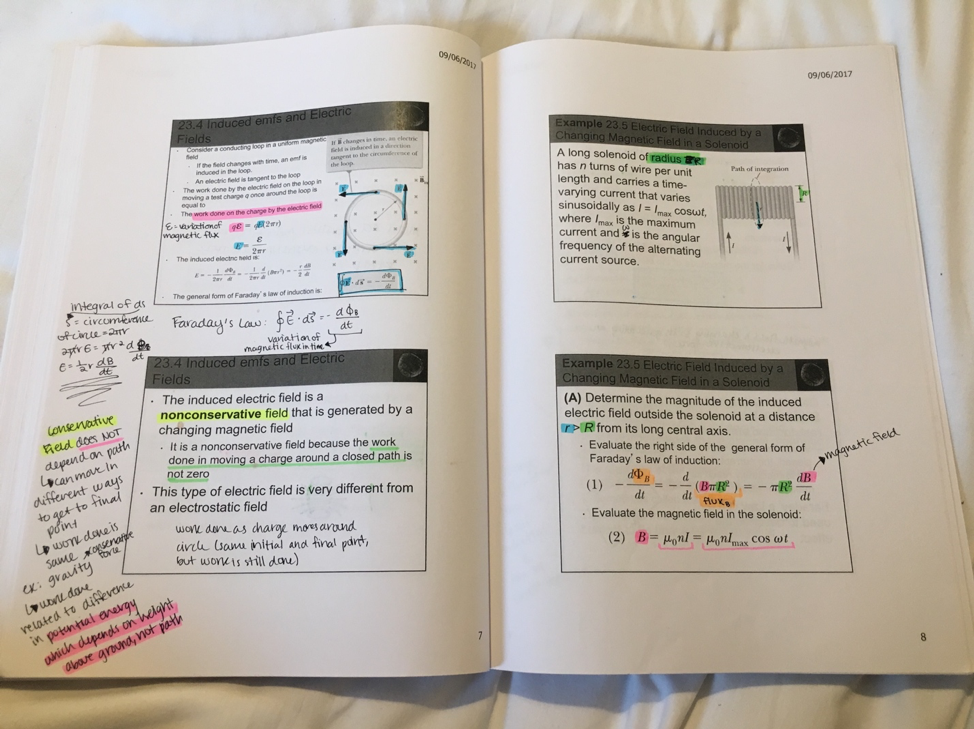
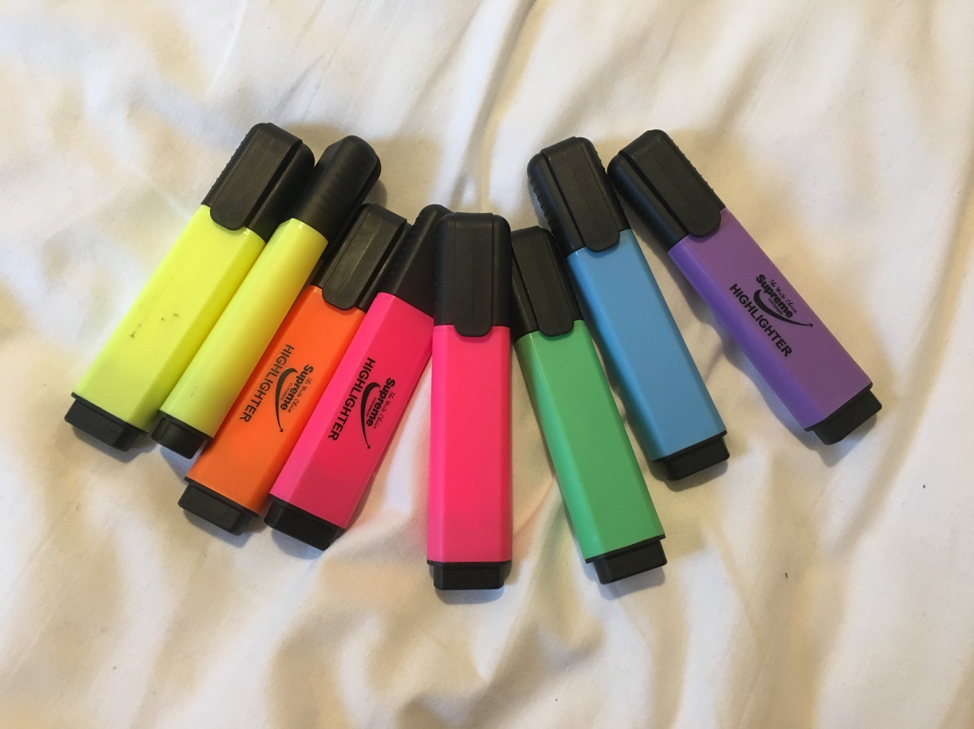
DO THE TUTORIALS (WITHOUT THE INTERNET)
You will have two hours of tutorial twice a week in which you work through a problem set in a group of three. I feel like I learned everything during tutorial (in terms of learning to do the actual problems). Please please please don’t just use Chegg to get all the answers down and leave as fast as you can. You’re only hurting yourself this way because while you may get good scores on tutorials and get out faster, you are not actually learning the material that you will need to know for tests. Staying late is more than worth it if you understand how to do the problems that will be very similar to test problems.
TAKE NOTES AT HOME
If possible, try to take notes on each lecture the day that it is given. This will help you stay on top of the material, ensuring that you understand it as you go along. The material does build on itself so it just makes it more and more difficult to understand if you are further behind. I found that color coding and highlighting worked really well for my learning style. This is especially useful when you get to the light unit. You’ll have a bunch of light rays all over the page, so color coding will help you keep everything in check. More than anything it just looks really nice and makes it a bit more pleasant to go back and review you’re notes when they are easy to read. The professor typically does several example problems in class so go back and redo those problems on your own as well to ensure your own understanding.


REDO THE TUTORIALS AT HOME
The tutorial problems are very similar to the test problems, so I would recommend going back and redoing the tutorial problems on your own a second time. It should be significantly easier the second time and then if it’s not, you know you need to study that material a bit more.
CRASH COURSE
Crash course was a lifesaver. Do not use this alone to learn the material, but I usually watched crash course during the break between lecture and lunch to recap what we learned in a short video that didn’t take too much brain power. There is an entire crash course physics playlist that pretty much covers every topic in the course.
MICHEL VAN BIEZEN
This man knows everything there is to know about physics so just check out his videos if you need any extra help.
https://www.youtube.com/user/ilectureonline/playlists?flow=grid&view=50&shelf_id=10
Not gonna lie, the course will be challenging and stressful, but I promise you are going to be ok. There will probably be times when you feel like you’re going to fail, but you will be fine. They do everything they can to help you succeed so please don’t let the stress ruin your time in Ireland or prevent you from having fun on the weekends. Good luck studying!!
Grace Heart studied abroad in Dublin, Ireland, in Summer 2017: http://eap.ucop.edu/OurPrograms/ireland/Pages/science_engineering_summer_uc_dublin.aspx
BY PARIS SUMPTER
Paris has her first day of Japanese language classes at International Christian University.
Paris Sumper studied abroad in Tokyo, Japan, in Summer 2017: http://eap.ucop.edu/OurPrograms/japan/Pages/language-and-culture-ICU.aspx
BY CELIA CODY-CARRESE
Living in another country is a wonderful experience full of new friends, new experiences, and travelling to new places. It’s also challenging, and it requires you to adapt to new circumstances. Moving to a Spanish-speaking country to study the language is a lot different than taking a class at a UC. From an academic and immersive perspective, here’s what I’ve learned.
Attending university in Córdoba has been very different from my regular college life at UCLA. At UCLA I go to a large university where everything is located on one campus. The University of Córdoba has different buildings throughout Córdoba, which each serve different groups of students. I attend classes at University of Córdoba Idiomas (Languages), or UCO Idiomas. One of the biggest differences between UCLA and UCO is that classes are much smaller in Spain. My biggest class here, Spanish History, has all 27 students in my program; but my Spanish Language and Andalucían History classes both have 15 students or less. At UCLA, my smallest classes (not including discussions) have about 60 people. Having smaller classes is a nice change, and I really feel like I know my professors- they are all very kind and funny, and attentive to the needs of students.
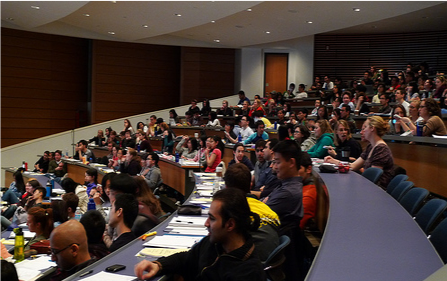
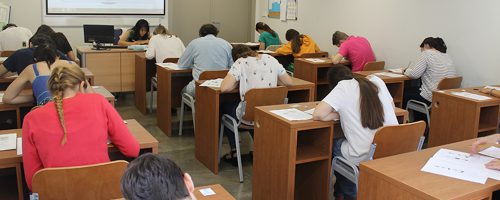
(An average class at UCLA vs. UCO Idiomas)
Teachers here generally teach in a different style- only one of my professors uses a prepared Powerpoint for his lectures. Another professor uses maps and images sporadically, but he mainly just lectures and writes on the whiteboard. Additionally, all of my classes here are taught in Spanish! The Andalucían History class, which is an elective, was originally taught in English, but we opted to have our professor speak Spanish. It has been a good way to practice and fully immerse while at school, and he is able to get his lessons across easier by speaking in his native language. At first I was worried about having History classes in Spanish- I figured I would not be able to understand enough, and would be ill prepared for the test. However, understanding another language is one of the first steps of language acquisition (it comes easier than speaking), so within a few weeks I was understanding most of what my professors were saying!
My schedule here is also a big shift from university life. In a normal quarter I also take three classes, which are spread out throughout the week- so I might have two classes on Tuesdays and Thursdays and one on Mondays and Wednesdays. I often have days with big gaps in between classes, and my days can change a lot depending on my academic and extracurricular schedule. Here from from 9:30 to 11:30 I have Spanish class Monday through Thursday, and from 12 to 2 I have Andalucían History on Mondays and Tuesdays, and Spanish History on Wednesdays and Thursdays. Every day we have a half hour break between classes, which is much needed time to recharge with a snack! On Fridays, we go on trips to historical and cultural sites in Córdoba and around Andalucía. Having class at the same time everyday is a big adjustment- I haven’t had a schedule like that since high school! While part of me misses the flexibility of having days off or big gaps between classes, I also really like the routine of waking up at the same time everyday.
There’s a cafeteria right across the street from UCO Idiomas, and I often have café con leche y tostada con tomate (a latte and toast with a tomato spread) for a snack during our break.
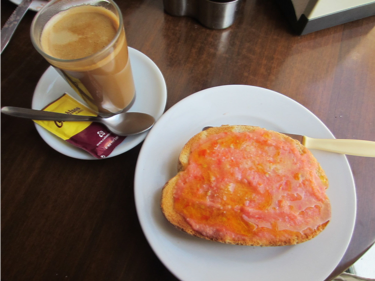
Another big difference here is the way grades and classes are structured. There is less work consistently given out, and more of your grade depends on testing. I have daily homework for my Spanish class, which usually takes me about 30 minutes to an hour, and most days I study more Spanish on my own. For the history classes I don’t have homework, and pretty much my entire grade depends on testing. My program is divided into Spring Semester students (who are in Córdoba until May) and Winter Quarter students (that’s me) who are here until March, and then returning to our schools for Spring Quarter. When we take our finals, the Semester students are also testing, but for them it is their midterms. Besides my Spanish class which also incorporates written assignments, my grades are based solely on testing and participation. It’s a little nerve-wracking, having your grade centered on one test, but I’m not too worried about the tests. One advantage of being a Quarter student in my program is that all your tests (except for Spanish, of course) are in English!
Your brain, on language acquisition.

Studying abroad, especially when you are learning a new language, is a different type of learning because you are constantly absorbing new information and expanding your knowledge. You don’t just go to class, learn something, study it, and then go about your life. What you learn in class is reinforced by your life outside of university, and vice a versa. In my Spanish class we are encouraged to talk about what we did over the weekend and bring in new phrases we learned. In history we learn about Al-Andalus, the name of Andalucía when Muslims ruled and the European Caliphate was centered in Córdoba. We learn about the Catholic monarchy of Fernando and Isabel and how they expelled the Muslims from Spain. Walking through Córdoba or Granada, architectural examples of Muslim and Christian culture can be found everywhere. And most importantly, I am surrounded by Spanish all the time- in my homestay, in class, in the street. This makes understanding and practicing Spanish much more accessible, and it becomes part of your life faster than it would without immersion.
It takes years and years of practice to become fluent in another language. By living in another country for a few months, you will improve and learn a lot- but you won’t become fluent. However, by immersing yourself and making an effort to practice every day, you are bound to improve, and lay the groundwork for communicating in another language!
Celia Cody-Carrese studied abroad in Cordoba, Spain, in Winter 2017: http://eap.ucop.edu/OurPrograms/spain/Pages/exploring_andalucia.aspx
BY CHRISTINE TRAN
Christine Tran’s photo blog shares scenes from UCLA Travel Study’s 2014 English Shakespeare program in London and Stratford-upon-Avon, England.
By BARRY YANG
A WEEK OF DELIGHTFUL LEARNING IN THE FRENCH STYLE
If you recall from last week, no delightful learning in the French style took place because all our classes were unexpectedly canceled (though some may say that was the French style in its truest form). This past week we had our very first taste of formal academia in the land of Francois Hollande.
A sunny day in Lyon. Auspicious sign of the great learnings to come.
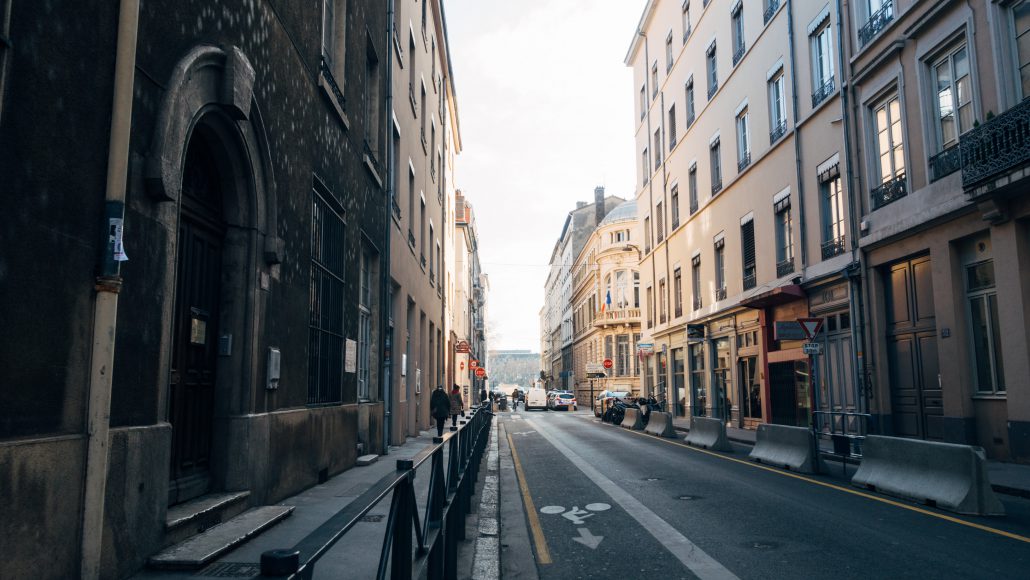
Imagine an approximate 400 square feet room filled with 5 rows of long desks accompanied with your standard issue schooling chairs. At the front of said room appears a jolly English fellow approaching the ages of 60 or 65 undressing the various layers he had cocooned himself in to combat the Lyonnaise cold. As he hangs his colorful scarf and readjusts his endearing bowtie, one cannot help but see this professor as a harbinger for a grand old time. Professor Martin Porter is one hell of a man, and a great representative of Liverpool as well as England. His speech is the perfect amount of wit, charm, suave, sarcasm, and British accent. He understands the subject matter (Imperialism) masterfully and is a connoisseur at presenting his knowledge in a pithy and entertaining manner. Understanding perfectly well our penchant for travel and novelty of Europe, Porter does not try to make his class more serious than necessary. He avoids busy work and encourages us to live history by visiting various sights throughout Europe as much as read about them. A man who has no need to compensate for his knowledge or status by being pretentious or overtly domineering, Porter is simply a jolly man who has some serious chops and is incredibly fun to learn from. He earned everyone’s respect within the first 30 minutes of the 2 hour class, and is the clear and definite highlight of our weekly curriculum.
The rest of our professors were also overall great. Although some of them dragged on and were overtly biased in their lectures, they all introduced interesting ideas which piqued our attention. Almost none of the of professors had slides or lecture material prepared and simply just talked on and on for 2 to 3 hours. It’s puzzling why classes are not shortened, because no one has the attention span fit for a French lecture. I snuck a look inside some larger lectures with just French students and at least half of them were on Facebook or online shopping.
Morale of the story: no matter where you go, all students zone out the same way.
This past week was a lot of firsts. Besides attending formal French class for the first time, I also got sick for the first time in about a year. The trams get very crowded in the mornings and afternoons, and I have noticed many people coughing and sneezing. Such close quarters and nights at the friendly neighborhood discotheque prove unhelpful in warding off sickness. Thankfully I was only out for one day, and missed only one class. This class happened to be the French language class which is offered at only one level, and that level just happens to be 400 times higher than 0 (the level which I reside and belong).
Needless to say, my absence from that class was sorely missed by Professor Christophe as I’m sure he enjoys just as much not understanding what I’m saying as I do what he is saying.
Hard at work, or hardly working? Definitely hard at work as we search for relevant historical sights on Pinterest.
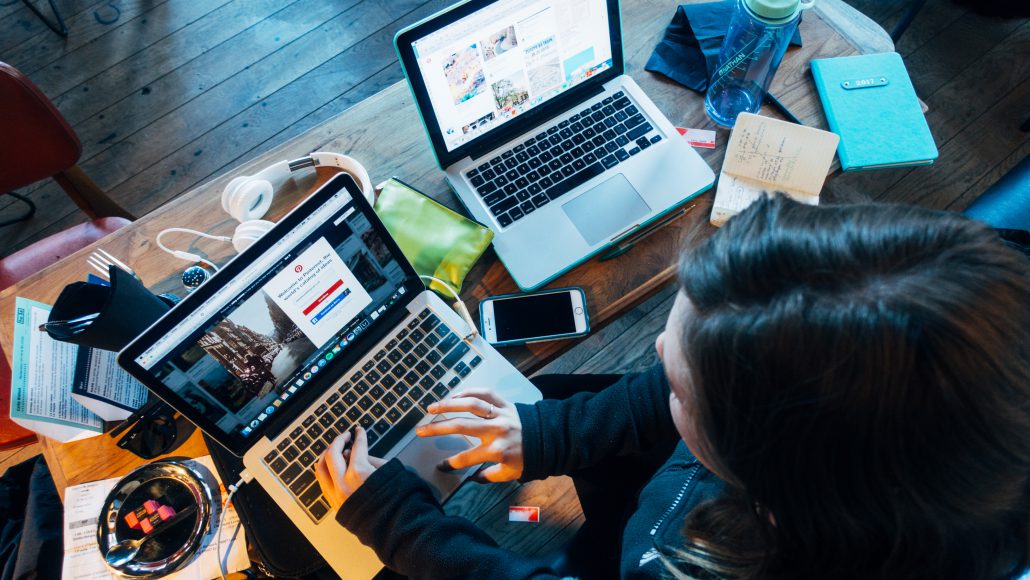
“Ahhh. Oui, oui c’est bon!”
– The words I use to respond to every question in French.
A WEEKEND “GETAWAY” TO MARSEILLE
There are many beautiful and famous cities in France that are worthy of visiting, at least according to my girlfriend’s Pinterest. Thus, we have made it a goal of ours to travel to as many French cities as possible during our time abroad. This weekend we got the opportunity to visit the port city Marseille. Armed with knowledge from a French TV show on Netflix called Marseille and a travel video about the city made in the 1970s, we set off to the beach by the beloved FlixBus. The FlixBus is actually not so beloved as it has been late every time we have ridden it and also the French police once forbade me from boarding the bus because apparently you needed a passport to go to Geneva (a fact that I’m not so sure is a fact because I had to go to Geneva by train after the 5-0 kicked me off, and nobody asked for my passport on the train or in Geneva). The ride was only 4.5 hours, which is child’s play when compared to the almost 8 hours we endured for Paris.
The city of Marseille definitely has character. While not the richest nor most beautiful city by any means, there is a certain aura about the city that one can respect and find even faintly charming. Prior to departing, my host dad warned me that Marseille was a very dangerous city with many thieves and that we must not wear any jewelry or watches on the streets; the same general thing was said by my girlfriend’s host mom. After going to Marseille, I can definitely see why my host dad and my girlfriend’s host mom said the things they did. The streets are much dirtier than Lyon and even Paris, and the buildings extremely dilapidated. There were parts of the city that were literally falling apart or had already fallen apart. However, given the lack of economic diversity in Marseille it is understandable why the city is at a lower socioeconomic strata.
For over 2000 years the city has been a trade port, and there is little other developed industry to this day. The city’s trade port history also partially explains the number of immigrants we encountered. During our stay we probably heard more Arabic than French, but that may have been due to the location of our AirBnB which felt very Moroccan.
Marseille was an overall good experience that was greatly tempered by the fact that we got sick halfway through the trip. There were many sights that we did not get to see in the city, but all in all we still had a great time. Week 4 in France has been filled with long long hours in the classroom as well as long long hours traveling. Some would say I am getting a very good handle on this work-life balance thing, and some would say I’m not even really in school. Whatever they say, I’am very fortunate and happy to be in France and look towards week 5 with unencumbered enthusiasm.
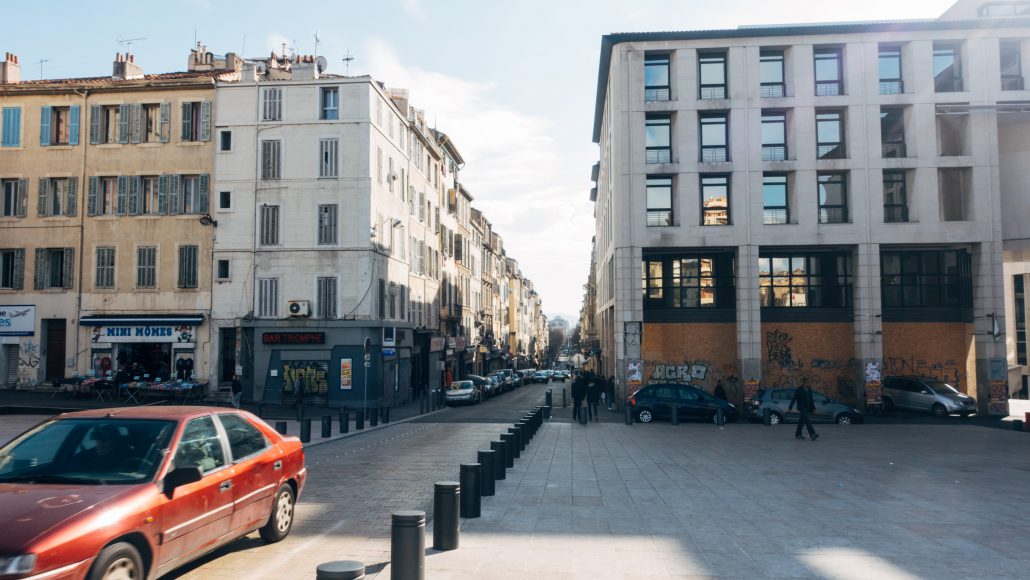
Barry Yang studied abroad in Lyon, France, in Spring 2017: http://eap.ucop.edu/OurPrograms/france/Pages/default.asp
By BARRY YANG
A WEEK OF ACCIDENTALLY SAYING BAD WORDS IN FRENCH AND OTHER FUN THINGS
Throughout my years in school, I have seen and experienced my fair share of unique teachers. However, out of all these unique teachers, none have been as poignant as Madame Sophie. The professor for our 10 person Justice and Globalization class, Madame Sophie is probably one of the most confusing yet interesting teachers I have ever had. A non-believer of lecture material, she simply just talks for 2 hours and will actively think out loud and remind us to remind her to not to forgot to talk about certain topics. A enthusiast for books and authors that none of us students from the states have ever head of, Madame Sophie is constantly in shock when half the class responds with puzzled looks whenever she drops the names of supposed renowned modern day political thinkers.
The Tram station at Part Dieu. I make this stop everyday when I switch to my second tram to get to school.
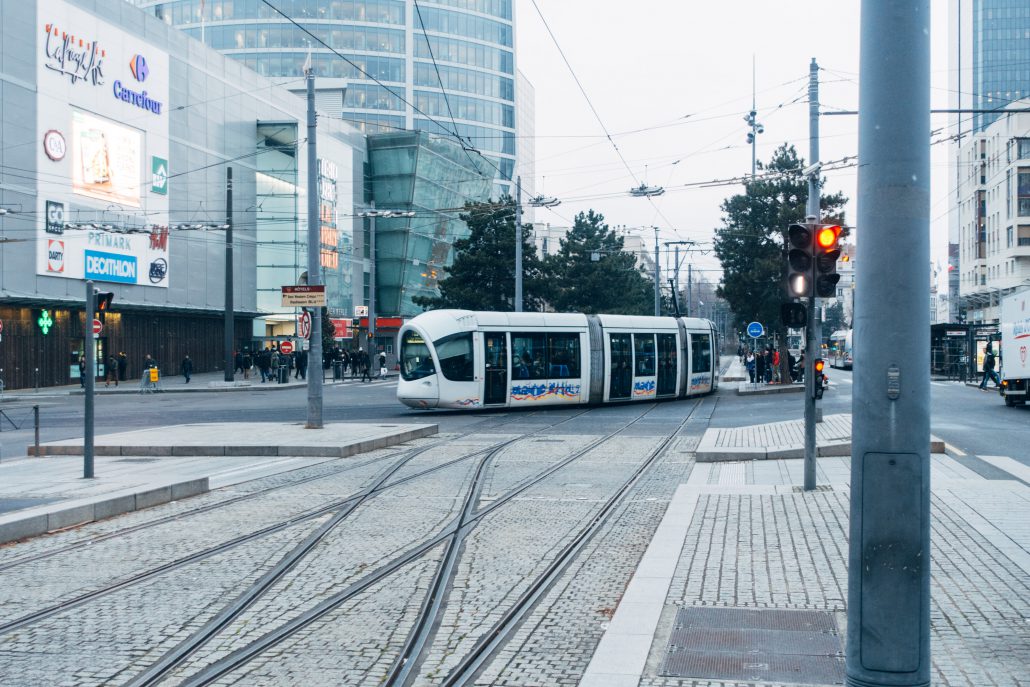
This week was our second time with Madame Sophie, and although none of us really have any idea what is exactly going on in the class, the discussions she sparks are at times very interesting. There are students from Turkey, Finland, Germany, and Switzerland in our class. It is very eye-opening to hear the different perspectives that my classmates have and how their cultures have shaped those perspectives. For example, towards the end of the lecture, Madame Sophie posed a very interesting hypothetical and pushed us to consider the roots of fairness and how our views on fairness are shaped by our respective country’s political and cultural environment. The example was about 3 individuals (Bob, Tom, and John) and who should receive a flute. Bob made the flute. Tom is the only one who can play the flute. John is very poor and has much less than both Bob and Tom. I answered that Bob should have the flute because he made it, while the students from Finland answered that Sally should receive the flute. Madame Sophie then pointed out how my thinking was very libertarian and textbook American thinking whereas the Finnish thinking was more communal. I thought this exercise was very interesting and I am excited to see what other questions she brings up next week.
Madame Sophie is undoubtedly an expert in her field and very knowledgeable of the subject matter. I am very excited for the class to progress and for us to get a better handle on the things she talks about.
Our program has many interesting professors and I look forward to writing about the others in the blogs to come!
MEET MY FRENCH DAD YVAN
My host dad, AKA French Dad, is probably the coolest French person I have met in this country. Yvan is 43 years old and incredibly funny, kind, and genuinely caring. As a social worker for the French government, Yvan deals with many young people and the experience he has garnered from his job really shows when you interact and talk with him.
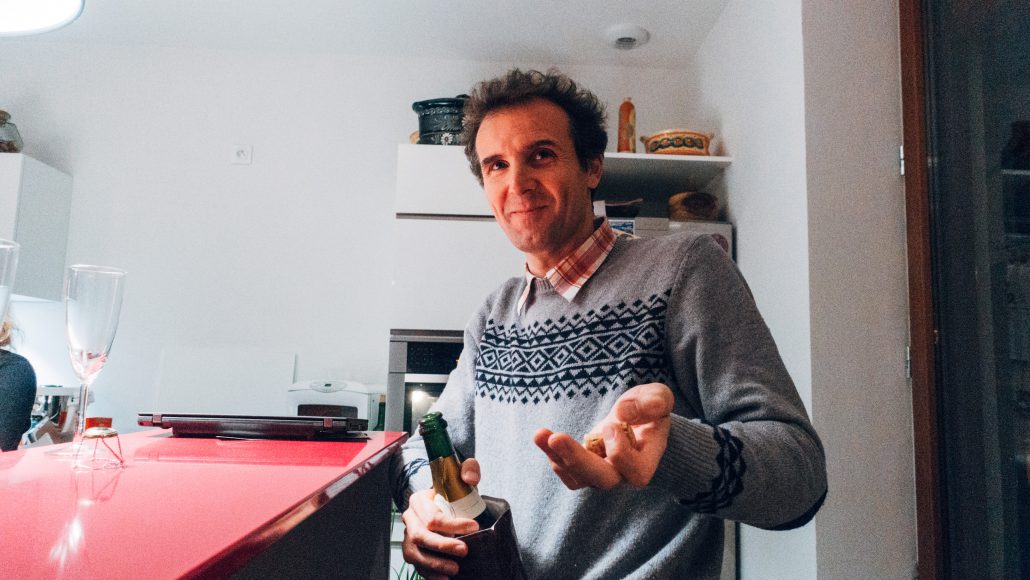
Always joking around with French and English swear words and not so PG jokes, Yvan is incredibly relatable and joyous. Although there is a pretty big language barrier between him and me, we still talk for hours about traveling, love, and sometimes his wife. He is an tremendously caring father to his kids and a great husband. Although he jokes around with his kids and wife, you can tell he takes his duties as a father and husband seriously. He is incredibly young at heart and thus very fun to be around.
Yvan has taken me on crazy bike rides around Lyon, shown me different types of cheese and wine, helped me find romantic restaurants and places to go with my girlfriend, and genuinely been there as a friend. I am incredibly happy I have this crazy French man in my life.
The rest of my host family is also very cool, and I look forward to introducing them in more detail in future blogs!
Yvan celebrating his birthday!
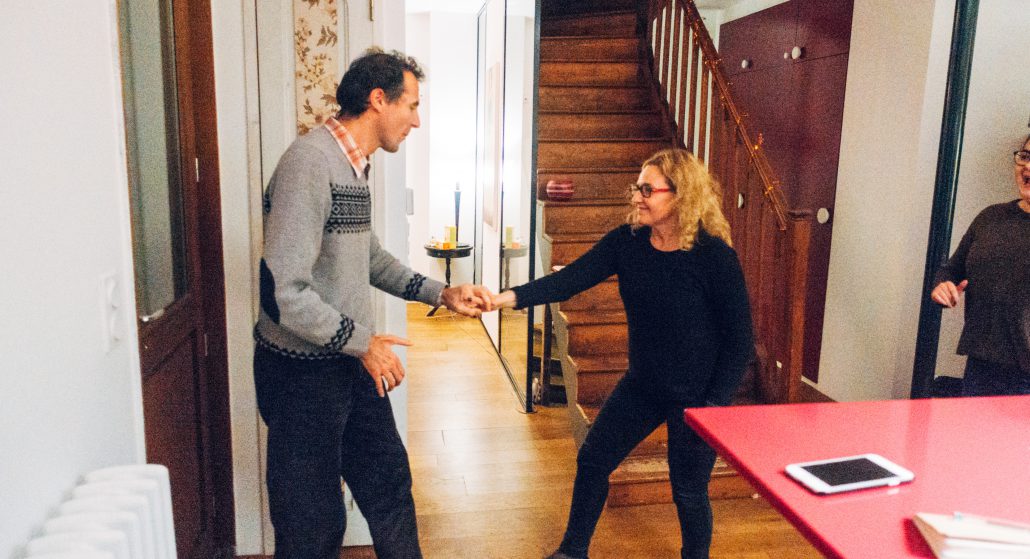
A WEEKEND IN A SMALL TOWN
Unlike our trip to Marseille, my girlfriend and I had an absolutely amazing time this pass weekend in Avignon. Avignon is a fairly small city in the Provence region of France. It is to the south of the Rhone river and home to many medieval remnants. Everyone we met in the city was incredibly nice. From our Airbnb host, to Majib our new friend whose owns the local bakery, to just store owners who find my inability to speak French and my girlfriend’s smile incredibly endearing. Everyone in Avignon just seemed to be more relaxed and very unpretentious. The food there was also much cheaper than Lyon and Paris.
You can easily see most of Avignon in a day, so the city is a very good place to go for a laid back weekend. We saw many beautiful castles and churches and tried a bunch of foods from the various little shops in the city walls (the city is literally surrounded by the ancient walls from medieval times).
Avignon is definitely worth visiting. It is cheap to get there. Accommodations are very nice and reasonable. The people are incredibly kind and laid back. The sights are amazing and the food great. What more could you ask for. I also got the opportunity to fly my drone and make a video of the small town; the video can be found here: https://youtu.be/ENg692XeUvc
Barry Yang studied abroad in Lyon, France, in Spring 2017: http://eap.ucop.edu/OurPrograms/france/Pages/default.asp
By WILLA GIFFIN
Hello to all my readers (comprised of my mom, dad, and if I’m lucky, younger brother)!
I haven’t written in far too long, so I’ll try to catch you up on as much as I can, as succinctly as possible.
I’m absolutely loving my time here so far, largely thanks to my study abroad program, Accent. The program has facilitated tons of cultural immersion opportunities for us, that I would not have been able to find on my own. This weekend they took us to Pisa and you bet I took the stereotypical tourist picture. After, we went to the most quaint, charming, bicycle town, called Lucca, (the birthplace of Puccini) where our waiter took our order and then biked down the street to pick up fresh bread for us to devour with our meal.
On Tuesday, the program is taking us to the opera, and then on Wednesday to a pizza making class, where our instructors are fourth generation pizza makers from Napoli, who speak zero English! Next month, Accent is taking us to Siena and San Gimignano.
One woman who works in the main office has also helped those of us who have expressed interest, find internships in Florence. On Monday, I’ll start working in a third grade classroom, teaching English to Italian children… Wish me luck! I barely have a third grade mastery of English myself (thank you spellcheck for hiding my biggest flaws), let alone the ability to teach it to Italian students.
Also, during our first weekend in Florence, Accent took us on an incredible walking tour around the city. It was so beneficial to hear about the rich art and cultural history of all the monuments I pass by daily, and I also appreciated getting an insider’s guide on where to get the best focaccia and which gelato to avoid like the plague. The tour was fairly long, but because my feet were numb from the cold, I could barely tell I was walking at all!
My individual process of adjusting to the cold temperatures here has been interesting, especially because this winter has been uncharacteristically cold for Florence (temperatures haven’t dropped this low since 1985, when the Arno River completely froze over and the Florentines could skate across it). As a girl from Southern California, I never expected to be so excited by the upcoming warm front in the forecast: a whopping 40 degrees Fahrenheit!
I’ve actually really enjoyed the cold though. It’s nice to bundle up and feel so cozy. Plus, I rarely unzip my jacket, so I could have my pajamas underneath, and nobody would ever know. Also, I like wearing so many layers because I can zip my valuables securely in the pockets of my innermost layer, and not have to carry a purse or worry about pickpockets; no one is getting my euro, buried three jackets deep! I’m also working on learning how to discern who is smoking a cigarette and who is just exhaling in the cold—so that’s a valuable party trick I’ll hopefully have mastered soon!
One day on my way to class, it started snowing—very, very minimally but it was snow nonetheless! This was the first time in a long time I had seen snow (not including the bubbles they drop on you at the end of the holiday firework show at Disneyland). It was absolutely magical. I was over the moon. I walked the full 20 minutes to school with my head back and tongue out, bobbing and weaving in attempts to capture the sporadic flakes.
When I got to class, all I wanted to do was stare out the window, and will the snow to continue, and maybe even stick! It didn’t. But then Cinzia (pronounced Chintsia), my Italian level 3 professor, walked in and immediately turned our classroom into a party, as she does everyday.
Originally, when I heard that my language classes were going to be Monday through Thursday, and three and a half hours long each day, quite frankly, I was worried. Often times at UCLA, no matter how interesting the material, I count down the minutes until my sometimes just bi-weekly, one hour long classes end. But this is so different. Cinzia is amazing, and apparently all of the other Italian professors in the program are too. She is 40 years old, but clad in her red leather jacket, cool leopard print boots, and a nose ring, she’s as hip and edgy as an 18 year old.
Cinzia always makes games out of our Italian lessons. Last week we played Pictionary with our new vocabulary of adjectives for personalities. Later that day, Cinzia placed Post-it Notes on our backs, labeled with celebrities’ names, our temporary identities. Without knowing who we were, we had to ask each other for hints as to who we were portraying, speaking only in Italian, of course. I was given Julia Roberts, but my classmates were little help in my attempt to guess my celebrity identity. Almost every question I asked—sono una atrice? (am I an actress), sono giovane? Vecchia? (Am I young? Old?) —was responded with, “Uh… I don’t know who that is.” They didn’t know who Julia Roberts was! It not only made me concerned that I was losing the game, but I was also worried about the future of our planet 😉
Cinzia’s loves to play Italian rock music for us, although her favorite band is Pearl Jam. She prints out the lyrics, has us stand in a circle, and makes us sing along with the song. Because we never know the melody, let alone the language of the lyrics really, our signing is usually an atonal, cacophonous mess, but a hilarious and fun mess, at that.
This week Cinzia split our class of ten into a group of five girls and five boys. She had us write our own Italian songs. Our girl group translated the lyrics to Beyonce’s “Single Ladies” into Italian (Tuttle le donne single) and came up with ridiculous choreography to match. Cinzia videoed our performance, and I’m pretty sure she posted it on YouTube somewhere, but I’d rather that stay hidden in the deep dark depths of the internet (along with anything I posted on social media before the 9th grade).
Everyday, halfway through class, at 10:30, Ciniza lets us out for a 20 minute coffee break. The ten of us leave class and peruse the combined farmer’s market and flea market that is directly outside of the school’s entrance. Students pick up fresh produce for the night’s dinner and try on vintage coats for the next time they go to the opera. Then, without fail, we always go either to Ricchi caffè or Volume for the rest of our break.
At the caffès (which are often called bars here), we all order in Italian, completely humbled, as we hem and haw and stumble over each word. We eventually get the message across, with the assistance of pointing and other types of exaggerated pantomiming. I get a cappuccino, and more often than not, a croissant (un cornetto—NOT corretto, which is a coffee with grappa!). We all stand at the counter because there is a “sitting charge” in Italy, plus it feels more sophisticated to stand at the bar. I sip and savor the liquid gold in my little cup, each swallow deepening my regret over time wasted on all past Starbucks orders. When we’re finished sopping up the last miniscule puddle of cappuccino with the heel of our croissants, we meander back to class, feeling energized and ready for more singing in Italian.
I actually think I am most happy when I am in class here, which is something I was absolutely not expecting to say. Besides thoroughly enjoying Cinzia’s interactive teaching style, going to school, and other typically mundane tasks (like grocery shopping or taking out the garbage) elevates this adventure for me. It transforms this experience from being an extended vacation, to feeling like I’m truly living here in Italy.
I often sit in class, a room that has been standing since the 1400s (longer than the US has been a country, which really baffles me) and I just marvel at the intricately hand-painted ceilings that almost rival the Sistine Chapel (which I actually got to see in Rome last weekend!!!). So much of this experience so far has felt like one big dream, and I’m worried that it will never really hit me that I’m actually here. But moments like these, when I’m sitting in the classroom, or picking out yogurt from the local grocery store, ground this experience in reality for me, and make me really appreciate this time for how truly special it is.
Next time I’ll tell you about my History of Food course, which is on a whole other level of delicious excellence! To be continued…
Willa Giffin studied abroad in Florence, Italy in Winter 2017: http://eap.ucop.edu/OurPrograms/italy/Pages/language_culture_florence_quarter.aspx
By GRACE HEART
Having just finished the midterm on Friday, we were all ready to get off campus. Our second program-organized day trip was Wicklow! Just south of Dublin, Wicklow is only about 45 minutes from UCD. The area was originally settled by the Celtics and later plundered by the Vikings from which it acquired its name. Today, the area is full of scenic hills and green fields.
POWERSCOURT ESTATES
We left campus at about 8:45am and made our way to Powercourt Estates. Nearly 50 acres, this large estate was originally a 13th century castle, later altered by a German architect in the 18th century. The name comes from the original owner La Poer which became “Power.” After a fire in 1974, the House was reconstructed. The view from the castle is absolutely breathtaking, one of the most beautiful views I’ve ever seen. We explored the estate, starting with the rose gardens at the bottom of the steps down from the castle. Next, we made our way over to the Japanese Garden. There was also a pet cemetery on the other side of the estate which was a bit odd. Apparently, it’s the largest pet cemetery in Ireland, but I’ve never really seen any sort of pet cemetery to compare it to so I guess I’d say it was pretty big. It is the resting ground for the pets of the Slazenger families, most recent owners. The cemetery includes horses and cows. We didn’t get a chance to see the tower, but everything we did see was stunning! We only spent about two hours at the estate, so try to be efficient in what you see if you want to explore the entire estate. There is a trail you can take around the whole thing, but we did spend a decent amount of time relaxing and taking photos.
GLENDALOUGH LAKES
After finishing lunch at restaurant near Glendalough, we drove over to Glendalough Lakes, within the Wicklow Mountains. It was a bit foggy on the day we went, but that’s pretty typical for Dublin weather. The view was still absolutely incredible. A few of my friends and I braved the cold and went knee deep into the water. So freezing. The hike to the actual lake was somewhat strenuous. We went through the woods and up some steep hills. It was gorgeous though, definitely worth the effort. Across the lake is St. Kevin’s Bed. This small cave is only about 25 feet above the water. Our guide told us about a legend regarding the cave. Apparently if a woman sits in the cave, she will always have safe childbirth. I’m not sure how accurate that is, but that’s what we were told haha. After about half an hour at the lake, we started hiking back to the buses and made our way home. The Wicklow day trip was absolutely incredible and had some of the most gorgeous views I’ve ever seen.
My favorite part of the day was our time at Powerscourt, but Glendalough was beautiful as well. Can’t wait for our next adventure!
Grace Heart studied abroad in Dublin, Ireland, in Summer 2017: http://eap.ucop.edu/OurPrograms/ireland/Pages/science_engineering_summer_uc_dublin.aspx
